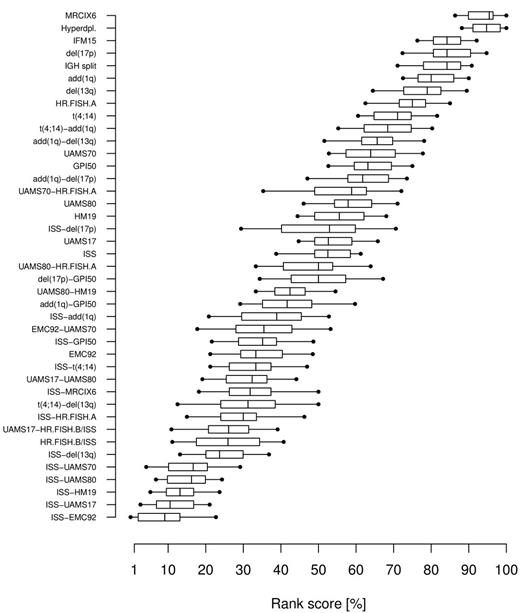Abstract
Introduction: The variable survival of multiple myeloma patients requires solid prognostic markers. It is unclear how currently used markers relate to each other. Here, ISS, cytogenetics and gene expression profiling (GEP) were combined to find novel risk stratifications in a discovery/validation setting. Next, novel combinations were compared with the currently existing markers.
Methods: The following datasets were used: HOVON-65/GMMG-HD4, UAMS-TT2, UAMS-TT3, MRC-IX, APEX and IFM (total number of patients: 4720). In total, 20 markers were evaluated, including cytogenetic markers (deletions of 17p (del17p) and 13q (del13q), gain of 1q (add1q) and translocations t(4;14), t(11;14), t(14;16) and t(14;20)), GEP markers (EMC92, UAMS70, UAMS17, UAMS80, MRC-IX-6, IFM15, HM19 and GPI50) and ISS. In addition, the combination of del17p, t(4;14) and ISS (Avet-Loiseau et al., Leukemia, 27:711-717; 2013) and the combination of del17p, t(4;14) and add1q (Broyl et al., Blood, 121: 624-627, 2013) were included. Reevaluation of markers was performed by Cox regression analysis stratified for cohort combined with the likelihood-ratio test. As a result, cytogenetic markers t(11;14), t(14;16) and t(14;20) were excluded. Thus, 17 markers were analyzed in the combination analysis (number of marker pairs: 136). This resulted in 24 combinations after validation. The Akaike information criterion (AIC) was used to rank the 41 markers (24 novel combinations and 17 existing markers). Importantly, to avoid training bias, training data were excluded when testing markers originally developed using those data (i.e. GEP markers and FISH/ISS).
Results: Reevaluation of existing markers in relation to overall survival (OS) demonstrated solid performance of poor-risk cytogenetic markers del17p, del13q, t(4;14) and add1q, but strikingly not for t(11;14), which is thought to predict for favorable outcome. The hazard ratios and p-values were 2.3 (p<1x10-15; del17p), 1.7 (p<1x10-15; del13q), 2.2 (p<1x10-15; t(4;14)), 2.0 (p<1x10-15; add1q) and 0.9 (p=0.5; t(11;14)). Top performing GEP markers EMC92 and UAMS17 demonstrated good performance with hazard ratios and p-values of 2.8 (p<1x10-15) and 3.0 (p<1x10-15), respectively.
In the subsequent pair-wise combination analysis, ISS demonstrated to be a valuable partner to both GEP and cytogenetic markers (Figure). Ranking all combinations as well as current markers showed that the ISS-GEP combinations consistently rank at the top. The EMC92-ISS combination was among the strongest predictors for OS, resulting in a four group risk stratification. In a pooled data analysis, the median survival was 24, 47 and 61 months and median not reached, for the highest-risk to the lowest-risk group, respectively. The highest risk group amounted to 17% and the lowest risk group to 38% of patients. Other high scoring combinations, ranking 2nd-5th, respectively, were ISS-UAMS17, ISS-HM19, ISS-UAMS80 and ISS-UAMS70. The compound FISH/ISS marker was in 7th position and ISS itself ranked 22nd out of 41. In general combinations of markers tended to perform better than univariate markers. The best univariate marker was EMC92 (14th out of 41).
Conclusions:
Both GEP and FISH markers are solid prognostic markers, with GEP markers demonstrating better predictions in unbiased comparisons than FISH markers. Prognostic markers can be improved by combining markers, as is evident when considering both existing combinations, such as the FISH/ISS marker proposed by Avet-Loiseau et al., and novel combinations. The EMC92-ISS model is a novel combination which is an improvement compared to currently used markers, offering a robust 4-group risk stratification based on biology and clinical parameters. This model is a good candidate to be validated in a clinical trial in order to stratify patients for treatment.
Van Vliet:SkylineDX: Employment. van Beers:SkylineDX: Employment. Mulligan:Millennium Pharmaceuticals: Employment. Gregory:Novartis: Research Funding; Schering Health Care Ltd: Research Funding; Pharmion: Research Funding; Celgene: Research Funding; Ortho Biotech: Research Funding. Goldschmidt:Janssen-Cilag: Honoraria, Research Funding, Speakers Bureau; Polyphor: Research Funding; Celgene: Honoraria, Research Funding, Speakers Bureau; Novartis: Honoraria, Research Funding, Speakers Bureau; Chugai: Research Funding, Speakers Bureau; Onyx: Consultancy, Speakers Bureau; Millenium: Consultancy, Speakers Bureau. Lokhorst:Celgene: Honoraria; Johnson-Cilag: Honoraria; Mudipharma: Honoraria. Sonneveld:Celgene: Honoraria, Research Funding; Janssen: Honoraria, Research Funding; Onyx: Honoraria, Research Funding; Millenium: Honoraria, Research Funding.
Author notes
Asterisk with author names denotes non-ASH members.


This feature is available to Subscribers Only
Sign In or Create an Account Close Modal